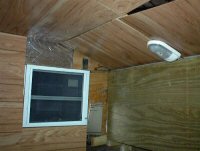The "tape" is cut from a sheet of glass cloth but not by cutting the cloth straight across or along the edges. The glass cloth is cut at 45 degrees to the edge. Mark out a line at 45 degrees with your favorite marker and remember that once marked as such, the mark cannot be removed and will show if you are retaining the clear glass look. This new cut now becomes the edge of your new piece of tape. Mark out the width you want and cut it very carefully. This is called cutting on the bias, your wife will know all about this. Once cut, the strip is rather unstable and will stretch and flex all over place and be out of shape. Just hang in there and lay it along the edge you want to stiffen up. By careful adjustment of the tape, you can get a nice straight edge on the two sides and have them remain parallel. Now look at the strands of glass threads, each strand is now holding the overhanging plywood and maximum strength is obtained. There is a huge bonus when applying the "tape" in this manner. The glass will conform into an internal corner without "springing" out as you apply the resin with a brush or stick of some kind. Two layers can be applied to the top surface if needed and the second layer is laid overhanging the first one. This feathers out the double thickness and can be sanded down along the edge to blend in with the surface of the plywood. Seal the wood first with resin as this prevents the raw wood being sanded when feathering in the glass cloth. For the ultimate in strength, the entire sheet of plywood can be covered in a sheet of glass cut on the bias. There is also another bonus when used this way. If the plywood should suffer a side impact with a sharp object, eg, a knife, a wire fence or similar, the biased glass has a huge resistance to penetration. The leading edges of my aircraft wings were covered in this manner and they had great resistance to damage and penetration when struck by a high speed wire fence or the edge of a steel roof.
If you are reinforcing an overhanging edge that is around 1 1/2" to 2" wide, a strip of glass 4" wide would be used or you can make it as wide as you want. Give this technique a try, you will certainly be impressed with the results when you do it.

Kody.
Kody is on the left in the avatar. I'm the one (Joe) with the less amount of hair,
Wherever I am, Kody is.
